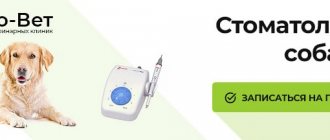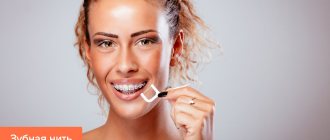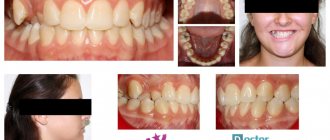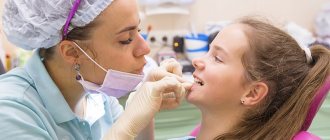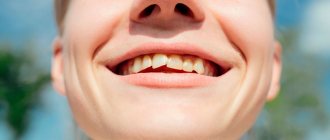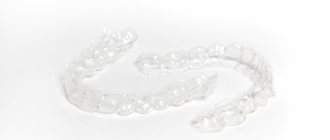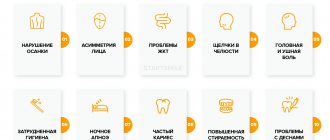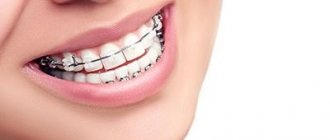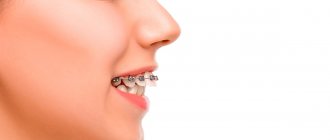For the sake of an attractive smile, many people subject their teeth to various procedures, as a result of which the teeth line gradually becomes even and smooth. The worst thing is if the fangs are uneven or protruding. Special braces for fangs will help get rid of this problem. You can read about the rules for their use here.
Braces for fangs
Problems with fangs
Orthodontists quite often see patients with crooked fangs: this is found in every third person. Here are the types of this problem:
- fangs are hidden behind the remaining teeth;
- fangs are turned to the sides;
- their height is outside the norm;
- they are only partially cut through.
There are several types of problems with abnormal canine growth
This dental abnormality is called a “vampire smile.” This name is appropriate both in appearance and because the patient has difficulty feeding. Due to an abnormality with the fangs, the corners of the mouth are raised, which can only be corrected with the help of braces.
Why are fangs positioned incorrectly?
This may well be a consequence of the fact that the fangs erupted too late. This happens when their growth begins at 9-12 years of age. At this age, the other teeth are well in place, so the fangs have almost no room to grow. And sometimes there are other teeth in the place that the fangs are supposed to occupy. Then the fangs have no choice but to grow in the second row. And this is already dystopia, a rather serious pathology.
What is dystopia?
Another incorrect location of the fangs may be due to the fact that the sizes of the teeth and jaw do not fit each other. Heredity is usually to blame. That is, the patient could have inherited a small jaw from one of the parents, and large teeth from the other. This is one of the reasons for abnormal development of fangs.
This can also happen if baby teeth are replaced by permanent teeth too late.
How long does it take for a permanent tooth to grow?
Almost all baby teeth erupt by age 3. At the age of 6, they gradually begin to be replaced by permanent (indigenous) ones. This process usually ends by age 13. If the total number of primary teeth is 20, then the molars are 32.
Interesting materials:
How to find out the serial number in the periodic table? How to find out the real number on Avito? How to find out the registration number of the certificate? How to find out the hidden number in iPhone? How to find out the owner of a car by license plate number? How to find out your IP address and port number? How to find out your Beeline number on an iPhone? How to find out your NTV Plus contract number? How to find out your IBAN number in Sberbank? How to find out your tax identification number?
Therapeutic methods for canine dystopia
This disease is detected without much effort. But whether it is difficult to treat is determined by several factors:
- neglect of the case;
- patient's age;
- nature of the disease.
How treatment is carried out depends on the specific situation
Here are the main therapeutic techniques:
- removal of a wisdom tooth in cases where the disease arose due to its growth;
- braces, and they often have to be used against the background of the removal of one tooth (usually a premolar) and the subsequent movement of the fang to where it should be;
- prosthetics or, as an option, conversion of the first premolar into a canine, if it is absent in the row;
- if the case is more severe, reposition.
Reposition
Important ! To ensure that the patient retains all of his teeth, it is useful to begin treatment as early as possible. People under 12 years of age use removable plates to straighten their teeth, and then not fully formed teeth are straightened in just three to six months.
A teenager under 15 years old needs braces to achieve the same goal. But for adults, dystopia usually cannot be cured without surgery.
- Braces for children
Who can benefit from braces, the required duration of wearing
The question about the purpose of using braces is asked mainly by those who do not have dental problems. Braces are also worn by those who do not have dental health problems. Typically, such devices benefit those with malocclusions and problems with their dentition. Interestingly, this can be found in 80% of all people. But only a few are worried enough about this to see a dentist. However, if there is no discomfort, this does not mean the absence of pathology. This is one of the unwritten rules of all medicine. So, for maximum confidence in the health of your teeth and the correctness of your bite, you need to make an appointment with an orthodontist.
Braces can help every person with canine growth abnormalities
The required period of wearing braces is determined by many factors.
| Factor | Description |
| The complexity of a particular case, individual characteristics of the pathology | The most important factor to consider when determining how long to use braces. For example, with the curvature of the teeth alone, it is less than with an incorrect bite or displacement of the entire dentition. So, it is possible to say how long you will need to wear braces to straighten your teeth only if you have information about the degree of curvature of the teeth and whether the patient has any other disease. |
| Patient age | As we age, the body experiences changes in physiology and anatomy. For example, the ability of the dentition to shift changes. It determines the period of use of braces. The older a person is, the longer he will have to wear them for the same pathology. |
| Bracket system | The bracket system may well consist of a variety of materials. Its design may also vary. All this determines the timing of wearing. Ceramic braces will take a little longer to use than metal braces. And lingual ones, due to their greater complexity, are also used longer than vestibular ones. Also, the period of wearing braces is determined by the manufacturer. The products of each orthodontic equipment manufacturer have their own duration of use. |
| Accuracy of installation, correct operation | When installing a brace system, the doctor must carefully observe certain parameters determined during diagnosis and selection of braces: width; height; tilt angle. Correct installation of braces by a doctor will greatly shorten the period of wearing them. The patient’s actions can also contribute to this: frequent and thorough cleaning of braces; proper nutrition; compliance with medical recommendations. |
| Purposes of wearing | The purpose of using braces also determines the duration of wearing them. For example, if, with a combination of malocclusion and crooked teeth, the purpose of wearing braces is only to straighten the teeth, orthodontic devices can be removed almost twice as soon as with a full treatment complex. |
| Doctor's experience and quality of work | What is also important here is how well and correctly the orthodontist works. With the best professionals, patients wear braces for less time, but with worse professionals, it lasts much longer. So, the average period of wearing braces is one and a half to two years. If everything goes smoothly (the installation is done efficiently, the patient properly cares for the braces, orthodontic pathologies have not developed beyond the initial stages), in principle, about a year is enough. If the case is more severe, treatment may take three years. |
The length of time you wear braces depends on many factors.
Correction of canine position disorders in dogs and cats
F. Genne
Violation of the position of the canines is a change in the bite, which affects their functional state.
Incorrect canine alignment can be caused by a misalignment of the primary teeth or an abnormality in the size of the mandible.
The categories of these deviations from the norm are determined by the orientation of the canines in space.
The first part of the article presents a classification of violations of the position of the canines, while the second discusses the issue of ways to eliminate defects.
Classification
Abnormalities in the position of the teeth In the transverse projection An anomaly in the position of the fangs is much more often noted in the transverse projection. It is mainly found at the level of the lower canines, the position of which has a pronounced direction towards the tongue.
This anomaly, called canine convergence, refers to linguoversion (severe inclination of the canines towards the tongue) or linguoposition (severe displacement of dental implants towards the tongue). The etiology of these dental disorders is not well understood. If in small breeds of animals the persistence of primary canines is the main factor of these disorders, then in others this cause of defect is encountered much less frequently. Also, the lower canines may have a pronounced inclination in the lateral direction (vestibular version), which is also called divergence.
As for the upper canines, violation of their position is much less common. We can observe their deviation towards the palate (due to the persistence of baby teeth).
In lateral projection In dogs and cats, rostral deviation (rostroversion) of the upper canines can also be observed. This is most often observed in small breeds of dogs (Yorkshire terrier, poodle, dwarf dachshund, etc.) due to the persistence of primary canines. In addition, depending on the breed, the persistence of primary canines causes a more or less pronounced disturbance in the position of the permanent canines. This feature is typical for Italian and Scottish Italian greyhounds (photo 1). In any case, particularly in these breeds, it is very difficult to establish whether the persistence of the primary canine is the cause of this type of disorder or whether it provokes rostroversion of the primary canine.
| Photo 1. Rostroversion of the upper canine in an Italian greyhound. A persistent milk tooth was recently removed (the wound caudal to the tooth), but a fragment remained. |
In cats of brachycephalic breeds (Persians, exotics), these disorders are of a specific nature. If there is rostrodeviation of the upper canines in association with the persistence of primary teeth, then it should be borne in mind that one of the reasons for the intensity of this pathology is the maxillary-facial modification that we observe in brachycephalic breeds. As for the lower canines, the violation of their position is caused by the rostral deviation of the upper canine or a skeletal anomaly, characteristic of brachycephals.
Vertical projection A fairly common anomaly in the position of the canines in the vertical projection is egression (progression of one or more teeth that do not have antagonists), and it is observed mainly in small breeds of dogs. Egression is also noted with malocclusion.
Violation of the position of the teeth associated with changes in the structure of the skeleton In the transverse projection As for the violation of the position of the main teeth at the level of the lower canines (“convergent canines”), it is recommended to introduce the term mandibular endognathium (narrowing of the lower jaw). This skeletal anomaly in transverse view corresponds to a pronounced "internal" displacement of the position of the canines in relation to the maxilla.
In the lateral projection In the case of upper or lower prognathism (or brachygnathism), a violation of the position of the upper canines in relation to the lower canines is noted, due to the shortening of one of the jaws.
These two anomalies are regrouped because they are predominantly volumetric anomalies (transverse and sagittal projection), in which the mandible is narrower or shorter (micromandibularia). In this case, the lower canines have a more internal and caudal position.
Guide to action
Reason for consultation and medical history There are two reasons for consulting a doctor:
- mainly rostral deviation or divergence of the lower canines (the aesthetic factor plays a role here);
- indications for treatment in case of anomaly of the lower canines in the transverse projection (convergent canines) or in the case of rostroversion of the upper canines or micromandibulia.
The main causative factors that must be taken into account are: breed, how long ago the anomaly occurred, the state of occlusion due to the replacement or spontaneous loss of primary teeth, the presence of primary teeth, as well as the presence of anomalies during the growth period.
Determining the severity of the violation The main significance is the violation of the position of the lower canines. Due to their size, changes in the position of these teeth, mainly in the transverse projection, negatively affect the condition of the gums or palate. Sometimes the disease develops before the change of baby teeth, but becomes more pronounced from the moment the permanent teeth appear (from the age of five months). Treatment should be carried out before the age of one year (photo 5, 6).
| Photo 5. Damage to the palate due to linguoversion of the lower canine in a puppy aged six months. It should be noted that the canines have not yet fully erupted. | Photo 6. Occlusion of the maxillary teeth in this dog indicates damage to the palate, which is localized in the space between the teeth. Effective orthodontic treatment was carried out (Fig. 1). The lips fit tightly to the upper canine, which ensures fixation of the removable appliance. |
| Figure 1. Treatment options for palatal injuries caused by mandibular canine malalignment. 1) – damage to the palate is noted in the sagittal plane in relation to the space between the angle of the canine and the first third of its width. Orthodontic treatment is required. 2) – damage to the palate, located in the sagittal projection at the level of the second third of the width of the canine. It is necessary to amputate the crown. 3) – damage to the palate, localized in the sagittal projection at the level of the third third of the width of the canine. It is necessary to carry out amputation of the tooth crown or orthodontic treatment aimed at repositioning the tooth caudal to the upper canine, the tooth should be located between this canine and the first premolar |
Rostral deviation of the upper canines provokes a more or less complete closure of the space between the teeth (forming the shape of an angle) into which the lower canines lie. Consequently, the lower canine, subject as a result of the above changes to a certain degree of lateral (vestibuloversion) and/or rostral (rostroversion) deviation, provokes injury to the upper lip or covers it.
Making a diagnosis At the beginning of the consultation, it is necessary to carry out a differential diagnosis, if possible, between skeletal anomalies and a violation of the position of the tooth.
An external clinical examination of the patient allows one to assess the degree of symmetry of the skull and facial surface of the head, as well as the position and shape of the main elements of the skeleton.
An oral cavity examination allows you to evaluate:
• occlusion of incisors, canines and premolars; • position of premolars (overfilling, rotation or displacement); • the shape of the mandible (straightness and parallelism in terms of occlusion or curvature with an open bite or gaping at the premolar level).
Before starting treatment, it is necessary to very carefully and completely examine the oral cavity under general anesthesia, which also makes it possible to conduct radiographic examinations inside the oral cavity. Radiography makes it possible to identify remaining fragments of the roots of primary teeth (photo 2), as well as to assess the stage of development of the roots of the corresponding teeth.
| Photo 2. Rostroversion of the upper canine in an Italian greyhound at the age of six months. The tooth is immature: the pulp canal is very wide, the root wall is thin, and the apex is unformed. It should be noted the persistence of a fragment of the root of a primary tooth (arrow). This persistence distorts the position of the main tooth. |
Treatment
Lower canines Lingual deviation of the lower canines Lingual deviation of the lower canines is most often accompanied by disturbances in the position of the teeth (linguoversion or linguoposition), the orthodontic treatment of which is quite well developed.
If baby teeth are still present, it is recommended to remove them immediately with care so as not to damage the root. In case of doubt, X-rays are used.
The decision for orthodontic treatment can be made when the lower canines have grown to half their height, which corresponds to the animal's age of approximately six months. The therapeutic option (choice), depending on the situation, is to install an active appliance between the lower canines or a passive one, which is also called functional, used on the upper jaw (at an angle).
If treatment is carried out before the full growth of the canines (at the age of 7 months), it is recommended to use:
• active flexible, usually hinged apparatus, so as not to change the direction of divergent growth of the lower canines; • functional appliance (angled), removable, designed for the upper jaw, which does not put pressure on the lower canines.
In addition, the transverse growth of the maxilla should not be inhibited during this period, which requires the use of an inclined hinged or “telescopic” appliance that meets these requirements (photo 7, 8). In adults it can be used with a fixed inclination.
| Photo 7. Installation of a functional removable appliance (inclined). The device is held passively using the lips. | Photo 8. The result of orthodontic correction after removal of the apparatus. |
Lingual and caudal deviation of the lower canines • Orthodontic treatment If the anomaly seen in the sagittal projection (caudal deviation) is not so pronounced, then a functional appliance (at an angle) can be used to correct the tooth(s) while simultaneously performing rostroversion (moving forward) or vestibuloversion (lateral displacement). During the examination, we can determine the boundary of the first third of the length of the upper canine (photo 6). The lower canines, which extend beyond its limits when the jaws are clenched (Figure 1, Photo 8), should be treated primarily in a different way: with the help of an active, more complex orthodontic apparatus (Photos 9, 10) or by amputation of the crown.
| Photo 9. Damage to the palate in the sagittal plane, at the level of the second third of the width of the canine. The most adapted treatment is crown amputation | Photo 10. Linguoversion and distoposition (more caudal position) of the lower canine. |
• Crown amputation Endodontic therapy is a priority when orthodontic treatment is contraindicated or undesirable. It allows you to avoid injury to the palate caused by the fangs if they are incorrectly positioned (photo 4, 8). This method of treatment is resorted to when the animals are over seven months old, because this corresponds to the period of formation of secondary, that is, more durable dentin at the crown level. This treatment is based on amputation of the upper part of the crown (approximately half). The tooth is then subjected to partial devitalization by eliminating the pulp (pulpotomy or partial pulpectomy). As a result of the manipulation, the formation of secondary dentin in the tooth crown is suspended. And vice versa, in its radicular (root) part the pulp is preserved: for this purpose we place a biological coating (“pulp combing”), which allows us to maintain its vital activity (normal root maturation) and in particular the closure of the apex (apexogenesis) and thickening of the root part of the wall tooth (secondary dentinogenesis). X-ray control for an objective assessment of its physiological formation is carried out after four or six months (photo 11, 12).
| Photo 11. Correction carried out by installing the maxillary and mandibular active apparatus. | Photo 12. Amputation of the crown with pulpotomy and “combing” of the pulp in a puppy at the age of seven months. The root is not yet ripe. Pulp brushing material and obturation are recognized by detecting a radiopaque mass. |
Rostral and vestibular deviation of the lower canines In case of deviation of one or two lower canines outward (lateral) and forward (rostral), the upper lip is captured, which is the reason for consultation. If the deviation is mild, then the canine(s) may rest against the upper lip.
This positional imbalance, either unilateral or bilateral, is common in brachycephalic cat breeds in association with skeletal disharmony. In this case, orthodontic treatment is not recommended, since the disorder occurs not at the level of the teeth, but at the skeleton. In cases where a violation of the position of the teeth is not associated with a skeletal abnormality, it is often unilateral (one-sided) in nature. The lower canine may be in a state of rostroversion due to that of the upper canine or an incorrect inclination of the tooth.
Orthodontic correction of canine alignment disorders involves the use of an active device that has an elastic module. Anchoring should be performed at least at the level of the lower premolars and molars to ensure secure anchorage.
Upper canines Rostral deviation In cases of severe rostroversion of the upper canines, the therapeutic choice is focused on tooth extraction or orthodontic treatment.
Treatment of this tooth pathology cannot be neglected, since the lack of its functional activity predisposes to the development of periodontal disease.
Due to the fact that this anomaly is mainly found in small breeds of dogs, this already indicates a high predisposition to the development of periodontal disease in them. Orthodontic treatment involves moving the upper canine back. This manipulation, due to the large volume of the root and, therefore, reliable fixation of the canine, requires a delicate approach.
Another difficulty is that the lower canine is in the path of the upper canine when it is displaced back and, if the anomaly is pronounced, then the visible part of the crown of the upper canine is very limited in size (photo 1). Finally, to ensure stability of the anchoring, multiple teeth must be involved. In this case, the active apparatus may consist of several buckles and/or elastic modules (photo 13, 14). The force of the elastic modules is adjusted using an orthodontic dynamometer.
| Photo 13. Radiographic follow-up performed 6 months later in a dog that had previously undergone crown amputation. Root maturation (closing of the apex and thickening of the root wall) indicates a favorable outcome of treatment, which preserved the viability of the pulp. | Photo 14. Maxillary active appliance, supplemented with an exiting buckle, designed for caudal displacement of the upper canine in a Chihuahua. |
An approximate standard when working with a cat is the force it produces, which is approximately 150 g (photo 15). The found normal occlusion of the upper canine relative to the caudal aspect of the lower canine may reduce the phase of natural retention provided by the interdigitation (cohesion) of these teeth.
| Photo 15. Active device, including elastic modules, used to distalize (caudally shift or lower) the upper canine in a cat. Simultaneous anchoring of the upper and lower jaws. |
Root maturation is regularly monitored using radiographic examination, which makes it possible to ensure the quality of orthodontic treatment, which does not have a negative effect on the pulp and root of the tooth (photo 3, 4).
| Photo 3. Orthodontic treatment of an Italian greyhound suffering from rostroversion. It should be noted that the apex of the tooth has not yet matured. | Photo 4. Control carried out after treatment. The appliance is removed after the tooth has been restored to normal occlusion, and attention should be paid to root maturation with closure of the canine apex, indicating that pulp vitality is preserved. |
Hygiene of the vestibule of the oral cavity and teeth is very important, and during the treatment period it must be carried out regularly. For this purpose, chlorhexidine gel is used, which is used daily by applying it to the teeth and gums.
Deviation of the palate, causing a violation of the position of the upper canines Deviation of the palate, causing a violation of the position of the upper canines, is an extremely rare anomaly in brachycephalic breeds of cats. It occurs due to the persistence of primary fangs. These teeth often cause aggression.
Malocclusion can be corrected very early orthodontically from the moment the canine reaches one third of its height. In this case, an active mini-device in the form of an elastic buckle is used, which makes it possible to tilt the upper canine in the lateral direction (photo 16). Treatment does not always allow achieving complete egression of the tooth.
| Photo 16. Tensioning the elastic chain using a dynamometer. The tension is adjusted to a weight value of approximately 150 g. | Photo 17. Maxillary active appliance, complemented by a buckle, designed to bring the upper canine laterally (to the position of vestibuloversion), arriving at the moment in a state of palatoversion. |
Conclusion
Violations of the position of the canines are common and are the cause of a violation of their occlusion, which is responsible for the disruption of their functional activity, which should not be neglected.
The clinician must offer adequate treatment. Scientific knowledge and its practical application in the treatment of animals are constantly evolving in veterinary medicine. Lack of treatment or tooth extraction is currently not the only solution to this problem. The veterinarian, depending on the wishes of the animal owner and his capabilities, either independently chooses the method of treatment or consults with his colleague.
SVM 4/2005
Rate material
Like Like Congratulations Sympathy Outrageous Funny Thoughtful No words
Tags
Odontostomatology Orthodontic system Bite
Leveling process
Usually, it takes two years for the fang to return to its proper place when using braces.
To do this, you need to free up the space where the fang will be located, that is, make the jaw wider or remove the tooth standing in this place.
If the second and fourth teeth are not too far away, the fourth ones are usually removed. If the fang protrudes just a little, you can do without removal. All that is required is to widen the jaw, while moving the teeth where they need to be.
Various types of braces can be used
When straightening fangs, both simple metal braces and those that look more beautiful - lingual, sapphire, ceramic - are useful.
Important ! In order to reduce possible risks, the therapeutic course should be started as early as possible.
How to wear a wolf fang
The best way to use the amulet is to wear it as a pendant on the chest. As a rule, a rubber strap or a silver chain is used. It can also be used as a pendant on a bracelet, the basis of which can be the same materials as in the previous version. The main thing is that the pendant in the shape of a wolf fang should be in contact with the body of the owner, so the power of the predator will better influence the person, combining with his own energy.
The best way to use a wolf fang amulet is to wear it as a pendant on your chest.
If you want to hide the talisman from prying eyes, put the Wolf Fang in a small bag made of natural linen and carry it with you at all times.
External factors, for example, constant contact with water and sunlight, can negatively affect the natural talisman - cracks will appear on it. If a fang is split in half, it becomes ineffective and should be disposed of.
When going to the sauna, to the beach, or just to take a shower, take off the amulet, otherwise it will gradually begin to deform from moisture. To ensure that the talisman lasts a long time, treat it with care.
In ancient times, a wolf's fang was hung on the wall near the family hearth to protect against evil spirits and negative people.
The owners of this amulet noted that at certain moments they seemed to feel their patron behind them, the strength of his protection and support.
Are braces really necessary to straighten fangs?
A large number of people do not want to wear braces. Moreover, not only aesthetics play a role here, but also the following possible reasons:
- Braces: before and after
- high cost of braces and necessary procedures;
- difficulties in predicting results;
- long-term rehabilitation.
There are other ways to fix fangs. The most optimal one can be selected based on the complexity of the case and the age category of the patient.
Correcting the position of fangs is easier for a child than for an adult
Interesting ! It is much easier for a child to correct his bite than for an adult.
Here are methods for correcting children's fangs that do not involve the use of braces:
- using mouth guards during sleep;
- removable and easy to maintain soft plates;
- trainers.
If an adult has noticeable problems with his bite, he is recommended to use braces. Only for minor diseases can other therapeutic methods be used. For example:
- removable aligners - the course of use is one and a half to three years, the smile does not deteriorate;
- veneers - the indication is only a minor disease that only affects appearance. Used if you need to fix things quickly. Thin plates that need to be attached to the teeth. It is difficult to notice them, there is no inconvenience, but they do not get rid of the problem.
Adults can use veneers
The doctor must decide which method of correcting the bite to use - braces or something else. He will conduct a full examination, get all the necessary results and, based on them, decide which technique to use.
No design eliminates the need for frequent visits to the doctor. He can give advice on this or that issue, and he will also monitor how correctly the treatment is going.
Video - Teeth straightening
How to power a dragon's fang
When you have enough star silver, as well as all the dragon fangs, go back to Orban, who will tell you to power the fangs at the heart in the cave. Follow to the desired area, where a battle with Fatui soldiers awaits you. Among them will be Electro, Geo and Piro Fatui. Their shields can be broken by Cryo, Geo (either electro+pyro or two-handed) and Hydro characters, respectively. In addition, Scarlet Quartz, which is scattered in this area, will help you in battle.
When you have dealt with the waves of enemies, head back to the blacksmith.
Using braces on canines
It takes about a year to two to use braces to get the fangs where they need to be and straighten them out. It happens that before installing braces, you need to remove one tooth or, alternatively, widen the jaw to free up enough space. If the curvatures are small, this is not necessary.
Fangs can be straightened using various braces: metal, ceramic, lingual, sapphire. For teenagers, results can be obtained more easily and in less time.
If the problems are related only to the fangs, you don’t have to install braces on the other teeth. Although the treatment will be faster, it will still take more than one year.
- Incognito braces
You can install braces only on fangs
Important ! There are various ways to straighten protruding fangs. The doctor must decide which one will be used, focusing on the severity and characteristics of the pathology.
The average treatment option looks like this:
- ridding the entire oral cavity of all diseases, including plaque, caries and stone;
- its examination, radiography, making casts;
- manufacturing a structure based on the data from the previous paragraph;
- freeing up free space, if necessary, expanding the jaw or removing some teeth;
- installation of braces;
- achieving results;
- removal of braces and selection of retainers, which the patient will have to wear for a certain period of time if he wants to consolidate the result.
Before installing the device, the doctor carries out preparatory procedures
Purpose of the wolf tooth talisman
An amulet with a wolf tooth is suitable for both men and women of any age. At the same time, he is able to enhance and reveal various qualities.
A talisman made of plastic, porcelain or other material will not be particularly effective. Only a real predator tooth demonstrates truly strong energy.
For men
The Wolf's Fang has a special meaning for men. Such a talisman helps make its owner more courageous, courageous and courageous.
With the help of an amulet you can cope with the following problems:
- get rid of doubts and fear;
- strengthen the spirit;
- improve physical development;
- develop intuition;
- protect yourself from negative emotions and feelings;
- improve sexual functions.
Using wolf teeth helps a man become more self-confident. Thanks to this, a person can act much more decisively at work. The talisman also provides reliable protection from evil people in the professional sphere. It helps you achieve a career advancement or expand your business.
A woman must present such an amulet to her husband. It will help protect against temptations and strengthen the bond between husband and wife.
For men who have not yet met their soulmate, the amulet has special meaning. It makes its owner more attractive in the eyes of women and helps to find the most worthy among them.
For women
Women have been using this talisman for love spells since ancient times. Young girls who wear a talisman will be able to find their soulmate faster. They literally become the center of male attention.
This effect of the sign is associated with the devotion of wolves, who grieve for a long time after the loss of loved ones. This is where the belief came from that the Wolf Fang helps create a strong family and preserve love for life.
The Wolf Fang is a powerful amulet that has a powerful mystical meaning.
For children
The amulet can be used as protection for a newborn child.
- The sign will protect the baby from the evil eye, dark thoughts, damage and envy. That is why, since ancient times, the Wolf's Fang was hung over a child's crib.
- In order for the child to grow strong and healthy teeth, he was given Wolf Fang to gnaw.
- The sign was also hung around the neck of capricious children. He helped the child calm down and become more disciplined.
Wolf teeth are also suitable for teenagers. They protect from the negative influence of envious people from the environment, protect from bad habits and unnecessary advisers.
Advantages and disadvantages of braces
This design has the following positive aspects:
- the ability to get rid of almost any jaw anomaly, and the stage of curvature does not play a role here;
- almost complete absence of contraindications;
- effectiveness can be seen already in the first months;
- can be used regardless of age category;
- the design is installed only in clinical settings. It is non-removable, so the patient does not need to put it on and take it off on his own;
- modern models are difficult to notice from the outside after installation.
Braces have many advantages
It also has its negative sides:
- Oral hygiene should be carried out more carefully. You also need to clean your braces well. Otherwise, pathologies such as caries, periodontitis, and gingivitis may develop. Moreover, while wearing braces, hygiene procedures must be carried out every time after eating;
- long wearing;
- minus in aesthetic terms. There are braces that look disgusting. However, some, for example, ceramic and lingual, are quite difficult to notice on the teeth;
- expensive compared to other systems that help correct teeth.
Many people refuse to wear such a device due to difficult dental care
Where to find star silver ore? (map)
Star silver ore is also used to craft the two-handed sword “Snowy Star Silver” (how to get its blueprint is in this guide ).
There are deposits of this ore throughout the dragon ridge, but more often there are 1-2 pieces. It’s easier to go through large deposits, and use single deposits to get the required amount.
Star silver can be collected once a day (or twice, we'll check). If you have the character Ning Guang, take her into your squad - any nearby ore will be displayed on the mini-map.
Refusal
The results of using braces are very good. However, sometimes patients do not want to resort to them.
This failure occurs for the following reasons:
- duration of therapy;
- high price;
- difficulty in forecasting;
- long rehabilitation.
Mouth guards can be used
It is the patient’s task to finally choose whether to use a braces system. For the same purpose there are mouth guards, trainers, and soft plates. However, for an adult they are useless.
Only mouthguards can correct the matter, and only if the fangs are only slightly protruding.
Mouth guards should be worn at night. Soft plates require much less effort to maintain than braces; on the other hand, the treatment period with them is longer than with braces. Trainers are easy to use, and they also have a targeted effect.
An adult can resort to lumineers or veneers. These devices are installed on the back side of the dentition.
- White braces
Care of braces and nutrition when using them
We talked about the timing of wearing braces. There is another important point that concerns many people - the necessary care of braces and proper nutrition during therapy. Keep in mind that not all foods can be eaten while wearing braces.
Here are the foods whose consumption is incompatible with the use of braces:
- solid plant foods;
- nuts;
- confectionery products such as sweets and toffees;
- tea, coffee, gas. water (when wearing ceramic/sapphire braces due to some staining due to such drinks);
- everything is very hot/cold;
- meat (if without proper care).
You will have to give up some food while wearing braces.
Important ! These tips are not a complete ban on all foods on the list. They only mean the need to reduce their use.
Hard fruits and vegetables can be softened by heat treatment, while meat can be chopped into steamed cutlets or put into casseroles. It is only important to eat gentle food.
The image of the wolf in different cultures
According to legends, wolves are the guardians of the moon.
There are many legends and myths about the reason for the sacredness of the wolf. People revered him for his courage, resourcefulness, and bravery. It was believed that the owner of a talisman in the form of a wolf fang receives part of its power, and the spirit of the predator will be his faithful protector and patron.
The image of a predator was found in different cultures, so there are quite a lot of legends about the sacred animal:
- According to some legends, the wolf guarded the Moon and the Sun. People believed that the end of the world would come when the wolf caught up with the moon.
- In ancient times, the Slavs believed in werewolves who could transform into a powerful beast and possessed the strength of a wolf. They believed that the god Veles from time to time turned into a wolf in order to walk the earth and look at people’s lives. The wolf's paw is considered one of the symbols of the deity.
- Some ancient legends said: the wolf could move between the afterlife and the world of the living. According to legend, when meeting a predator, you had to name three names of deceased relatives. If the sacred beast saw them in the world of the dead, it did not harm the person.
- In ancient Egyptian culture, the image of the wolf also had its place. According to legends, the god of war in Ancient Egypt, Upuat, had the appearance of a wolf. He was considered a guide and scout for the pharaoh on military campaigns. Upuat cleared the way for the pharaoh's army, protecting and moving it forward. In honor of this god, the city of Lycopolis was named, which means “city of wolves.” The talisman, identified with the wolf god, accompanied the pharaohs during the hunt.
- Another ancient Egyptian deity is associated with the image of a wolf. Anubis, a god with the head of a black wolf and a human body, judged the dead and escorted them to the afterlife.
- The Greeks depicted wolves as guardians of various gods.
- Some peoples believed that this predator protects people. For example, he eats wild boars, which means he protects crops from these animals and people are less likely to suffer from hunger. If a wolf dragged an animal from a barnyard, this was considered a sign that an evil spirit had entered the cattle, and the animal thus protected people from evil.
Rite of Anubis.
Painting from the tomb of Sennedjem. Basically, the sacred animal was considered a friend of man. They made sacrifices to him, made statues in the form of a predator, and expressed their respect in other ways.
What do the experts say?
Braces are required mainly to correct the bite and prevent pathologies that may appear due to problems with it.
Braces are especially good for normalizing your jaw. This is easy to notice when comparing the dentition before and after a course of therapy. As a result, the patient receives not only a beautiful smile, but also natural chewing function and speech. And there are almost no contraindications for braces.
There are no contraindications to wearing braces
The use of braces is not a reason for embarrassment for an adult, unlike crooked teeth and problems with bite. If you can get a beautiful smile, you should use it. And for this you simply need such a device.
Rehabilitation
Contrary to the stereotype, braces are not the last stage in the treatment of malocclusion. After their removal, a long period of recovery and adaptation begins.
No matter how long you have to wear braces, once you remove them, you should install retainers. This is a special wire-like design. It is placed on the inside of the dentition. Because of this, retainers are invisible. And they are also very comfortable. Retainers are necessary to secure the results of wearing braces.
To consolidate the result, retainers are worn
Results
The result of using braces is influenced not only by the professionalism of the orthodontist, but also by the patient’s compliance with his recommendations, and to no lesser extent. Here are the recommendations that the patient should follow:
- wearing elastics;
- high-quality oral hygiene.
Important ! If a specialist notices a lack of oral care, he can easily refuse to install braces.
A person must maintain oral hygiene
Patients' opinions
Alla, 30 years old
“I was forced to use braces by the doctor’s words about the prospect of losing all my teeth if the bite is not corrected. The treatment took two years, but I got a perfect smile. After some time, gaps became noticeable between the teeth. It turned out that this was the result of a medical error: the dentist simply forgot to prescribe mouth guards. Now I always wear them, which little by little brings my smile back to normal.”
Most often, people respond positively to wearing braces on their fangs.
Alexander, 41 years old
“My son wore braces for a little less than a couple of years. There was some discomfort during installation and tightening. He also couldn't eat anything that wasn't liquid. When wisdom teeth appeared, the teeth continued to pile up. In a word, the braces system helped, but not for long.”
Olga, 26 years old
“I had braces for over a year. Before this, I spent a long time looking for the most suitable clinic and doctor for installation. Then the correction process began, which was not very pleasant. She devoted a lot of time to keeping her mouth clean. At the same time, I used a variety of cleaning methods.
At first it was very painful, I had to take a lot of painkillers. But now the result exceeds all expectations, thanks to which I am extremely happy and grateful to the doctor. My teeth are straight and my smile is amazing. There’s only one downside, and it’s a minor one: you still need to wear mouth guards at night.”
